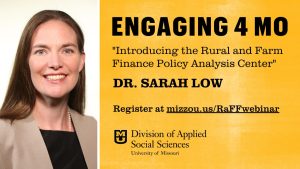The University of Missouri (MU) College of Agriculture, Food and Natural Resources (CAFNR) has formed a new Rural and Farm Finance Policy Analysis Center (RaFF). The center will study how policies and agricultural markets affect farm and rural finances by U.S. region.

RaFF will work closely with the College’s Food and Agricultural Policy Research Institute (FAPRI), a CAFNR Program of Distinction. FAPRI provides objective policy and market analysis at the national level.
“The Rural and Farm Finance Policy Analysis Center will help rural and farm communities by providing decision-makers with objective policy and market analysis,” said Christopher Daubert, vice chancellor and dean of CAFNR. “I am excited to see the resources this center creates for Missouri communities and beyond.”
By taking a regional approach to its analysis, RaFF will assess financial conditions with detail not available from a national analysis. Policy decisions and market movements don’t necessarily have similar effects for all rural regions. A region’s climate, available market opportunities, technology adoption and other factors can shape how it weathers challenges and responds to opportunities. RaFF will make its unbiased regional analysis available to Congress, which can use the information to better understand the nuances of how policies and markets affect people and communities.
“The Rural and Farm Finance Policy Analysis Center’s emergence is timely given the unique nature of the 21st century structural changes occurring in both the farm and rural sectors,” said Joe Parcell, director of the Division of Applied Social Sciences (DASS). “As economic and social changes take hold, policy changes will be explored by decision-makers, opinion leaders and policy leaders. The Center’s staff will be thought leaders in evaluating these policies and then communicating out the social and economics trade-offs amongst ideas.”
One project the center will undertake involves developing forward-looking farm income estimates by state, said Sarah Low, director of RaFF and associate professor of regional economics in DASS.
The center will also create and disseminate issue briefings throughout the year. Each will highlight a timely rural or agricultural issue. The first briefing focuses on agriculture’s contribution to the rural economy.
“We are not developing policies or proposals,” Low said. “We are providing unbiased analysis for policymakers. This will hopefully help them better understand what is happening in rural and farm communities.”
Along with Low, the center has a collection of contributors who will dedicate part of their time to the center. These individuals are passionate about modeling as well as farm and rural communities, she said. Many of these contributors are also part of FAPRI.
RaFF will also rely on collaboration with other states. On-the ground collaborators will help RaFF fine-tune the state farm income models.
“Many states have farm income models, but everyone generally makes different assumptions, uses different equations and otherwise follows different approaches,” said Low. “By working together in a coordinated collaboration, eventually the center will be able to stitch state farm income models together. This will help everyone better understand what would happen in different regions.
“We will start off small, working with a few states. The hope is eventually that we will have a whole network of different state farm income models.”
Generally, these collaborators will be Extension professors at other universities, Low said. Those partners can then take their models and results out into their respective states.
“We are really excited to have these partners on board. They are bringing the local knowledge that will be put into models so we can customize them for every state,” she said. “By having this coordinated collaboration and local knowledge from our partners in each state, it is going to help us customize these models in ways that we will be able to put them together. These models will help answer questions that need to be answered.”
The center has been in the works for several years, Low said. FAPRI identified a need to expand the national analysis it provides and track how policies and markets affect regions across the U.S. The USDA Office of the Chief Economist provides funding for RaFF.
“I am excited to see where this center can take us and the impact it has on rural and farm communities,” said Low. “The center is looking to build our network of collaborators, and we are looking for input on ideas for the issue briefings series.
“I am really excited about the center because I love policy and I love helping rural communities. That is where my passion truly lies.”
Find more information about the Rural and Farm Finance Policy Analysis Center on its website. For updates, follow the center on LinkedIn, Facebook and Twitter.
At 10 a.m. on Wednesday, March 9, Low will present “Introducing the Rural and Farm Finance Policy Analysis Center” as part of DASS’ Engaging 4 MO webinar series. During the 30-minute webinar, she’ll share more details about RaFF and highlight its first issue brief about rural economic drivers. The event is free and open to the public. Register for the virtual event online.